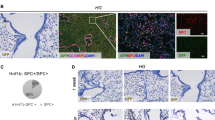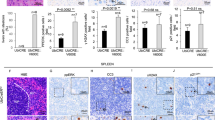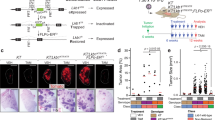Abstract
The Pulmonary adenoma resistance 2 (Par2) locus of the BALB/cByJ mouse, located within 0.5 cM of chromosome 18, is responsible for reducing the mean multiplicity of urethane-induced lung tumors relative to those in C57BL/6J, A/J and C3H/HeJ mice. Thus, BALB/B6-Par2 congenic strain genetically identical to BALB/cByJ except carrying C57BL/6J Par2 alleles develops seven times more tumors than BALB/cByJ. To gain clues for identification of Par2 candidate genes, we analysed lung tumorigenesis in BALB/cByJ↔BALB.B6-Par2 chimeric animals. Of 100 tumors induced by urethane in 16 chimeras, 82 originated from BALB.B6-Par2 cells, indicating the Par2 phenotype to be cell-autonomous. In addition, the BALB.B6-Par2- and BALB/cByJ-derived tumors were similar in mean size, implying that the phenotype is primarily expressed during initiation rather than in the promotion stage of carcinogenesis. Given these results, we surveyed a comprehensive mouse genome database and physically mapped Par2 within a 2.3 Mbp segment containing three known genes, Polı, Mbd2 and Dcc. Among those, the Polı seemed to be the most reasonable Par2 candidate, since it encodes an extremely error-prone DNA polymerase preferentially incorporating G or T opposite template T in vitro, reminiscent of the Kras2 activation because of an A to G or T point mutation within codon 61 with which most urethane-induced lung tumors are initiated. Indeed, our sequencing of Polı cDNAs from BALB/cByJ, C57BL/6J, A/J and C3H/HeJ lungs revealed 21 BALB/cByJ-specific single-nucleotide polymorphisms in the coding region accompanied by seven amino-acid substitutions and an elevated frequency of alternative splicing, while no polymorphisms associated with tumor susceptibility were found for either Mbd2 or Dcc. Notably, we obtained evidence that BALB/cByJ Par2 alleles may selectively decrease the frequency of Kras2-mutated tumors compared with C57BL/6J alleles. Consequently, the Polı is an intriguing Par2 candidate clearly deserving further evaluation.
This is a preview of subscription content, access via your institution
Access options
Subscribe to this journal
Receive 50 print issues and online access
$259.00 per year
only $5.18 per issue
Buy this article
- Purchase on Springer Link
- Instant access to full article PDF
Prices may be subject to local taxes which are calculated during checkout




Similar content being viewed by others
Abbreviations
- A:
-
A/J
- B6:
-
C57BL/6J
- C3H:
-
C3H/HeJ
- Pas1 :
-
Pulmonary adenoma susceptibility 1
- BALB:
-
BALB/cByJ
- Par2 :
-
Pulmonary adenoma resistance 2
- DEN:
-
diethylnitrosamine
- PCR:
-
polymerase chain reaction
- SNP:
-
single-nucleotide polymorphism
- RT:
-
reverse transcription
- β2-MG :
-
β2-microglobulin
References
Bebenek K, Tissier A, Frank EG, McDonald JP, Prasad R, Wilson SH, Woodgate R and Kunkel TA . (2001). Science, 291, 2156–2159.
Chen B, Johanson L, Wiest JS, Anderson MW and, You M . (1994). Proc. Natl. Acad. Sci. USA, 91, 1589–1593.
Cooper HM, Armes P, Britto J, Gad J and Wilks AF . (1995). Oncogene, 11, 2243–2254.
Devereux TR, Anna CH, Patel AC, White CM, Festing MFW and You M . (1997). Carcinogenesis, 18, 1751–1755.
Devereux TR, Wiseman RW, Kaplan N, Garren S, Foley JF, White CM, Anna C, Watson MA, Patel A, Jarchow S, Maronpot RR and Anderson MW . (1994). Mamm. Genome, 5, 749–755.
Dragani TA, Manenti G and Pierotti MA . (1995). Adv. Cancer Res., 67, 83–112.
Festing MFW, Yang A and Malkinson AM . (1994). Genet. Res., 64, 99–106.
Gariboldi M, Manenti G, Canzian F, Falvella FS, Radice MT, Pierotti MA, Della Porta G, Binelli G and Dragani TA . (1993). Nat. Genet., 3, 132–136.
Haracska L, Johnson RE, Unk I, Phillips BB, Hurwitz J, Prakash L and Prakash S . (2001). Proc. Natl. Acad. Sci. USA, 98, 14256–14261.
Hendrich B and Bird A . (1998). Mol. Cell. Biol., 18, 6538–6547.
Johnson RE, Washington MT, Haracska L, Prakash S and Prakash L . (2000). Nature, 406, 1015–1019.
Karasaki H, Obata M, Ogawa K and Lee G-H . (1997). Oncogene, 15, 1833–1840.
Lee G-H, Kawaguchi T, Nomura K and Kitagawa T . (1987). Hepatology, 7, 937–940.
Lee G-H, Matsushita H and Kitagawa T . (2001). Oncogene, 20, 3979–3985.
Lee G-H, Nomura K, Kanda H, Kusakabe M, Yoshiki A, Sakakura T and Kitagawa T . (1991). Cancer Res., 51, 3257–3260.
Malkinson AM and Beer DS . (1983). J. Natl. Cancer Inst., 70, 931–936.
Manam S, Storer RD, Prahalada S, Leander KR, Kraynak AR, Hammermeister CL, Joslyn DJ, Ledwith BJ, van Zwieten MJ, Bradley MO and Nichols WW . (1992). Mol. Carcinogen., 6, 68–75.
McDonald JP, Rapic-Otrin V, Epstain JA, Broughton BC, Wang X, Lehmann AR, Wolgemuth DJ and Woodgate R . (1999). Genomics, 60, 20–30.
Obata M, Nishimori H, Ogawa K and Lee G-H . (1996). Oncogene, 13, 1599–1604.
Tissier A, Frank EG, McDonald JP, Iwai S, Hanaoka F and Woodgate R . (2000a). EMBO J., 19, 5259–5266.
Tissier A, McDonald JP, Frank EG and Woodgate R . (2000b). Genes Dev., 14, 1642–1650.
You M, Wang Y, Stoner GD, Maronpot RR, Reynolds SH and Anderson MW . (1992). Proc. Natl. Acad. Sci. USA, 89, 5804–5808.
Zhang Y, Yuan F, Wu X, Taylor JS and Wang Z . (2001). Nucl. Acids Res., 29, 928–935.
Zhang Y, Yuan F, Wu X and Wang Z . (2000a). Mol. Cell Biol., 20, 7099–7108.
Zhang Z, Lin L, Liu G, Wang M, Hill J, Wang Y, You M and Devereux TR . (2000b). Exp. Lung Res., 26, 627–639.
Acknowledgements
We thank Drs F Hanaoka and C Masutani for valuable discussion. This work was supported by grants from the Ministry of Education, Culture, Sports, Science and Technology (G-HL, TT), the Ministry of Health, Welfare and Labor (G-HL) and the Okinaka Memorial Institute for Medical Research (G-HL), Japan.
Author information
Authors and Affiliations
Corresponding author
Rights and permissions
About this article
Cite this article
Lee, GH., Nishimori, H., Sasaki, Y. et al. Analysis of lung tumorigenesis in chimeric mice indicates the Pulmonary adenoma resistance 2 (Par2) locus to operate in the tumor-initiation stage in a cell-autonomous manner: detection of polymorphisms in the Polı gene as a candidate for Par2. Oncogene 22, 2374–2382 (2003). https://doi.org/10.1038/sj.onc.1206387
Received:
Revised:
Accepted:
Published:
Issue Date:
DOI: https://doi.org/10.1038/sj.onc.1206387
Keywords
This article is cited by
-
The error-prone DNA polymerase ι provides quantitative resistance to lung tumorigenesis and mutagenesis in mice
Oncogene (2014)
-
Y-family DNA polymerases in mammalian cells
Cellular and Molecular Life Sciences (2009)
-
The Kras2 oncogene and mouse lung carcinogenesis
Medical Molecular Morphology (2008)
-
A novel mouse Chromosome 2 congenic strain with obesity phenotypes
Mammalian Genome (2004)



